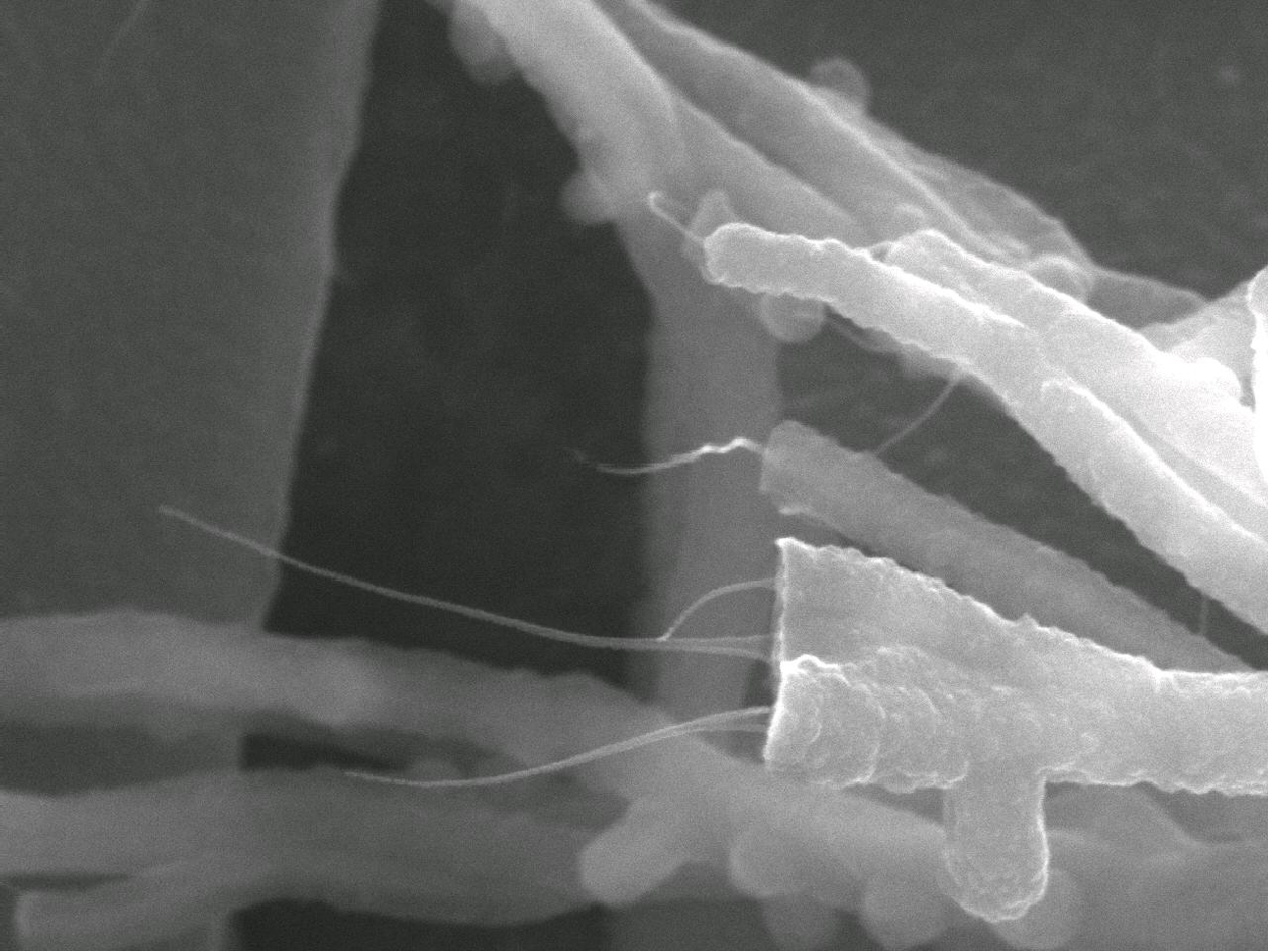BARRON RESEARCH GROUP
228th ACS National Meeting
August 22-26, 2004
Philadelphia, PA
![]()
Sidewall functionalization of single-wall nanotube by chemical derivatization of fluoronanotube
Lei Zhang1, Andrew R. Barron2, Jianzhong Yang1, John L. Margrave3, and Valery N. Khabashesku2. (1) Chemistry, Rice University, Houston, TX 77005, Fax: 713 348 5619, lzhang76@owlnet.rice.edu, (2) Department of Chemistry, Rice University, (3) Department of Chemistry and Center for Nanoscience and Technology, Rice University
The recent experimental studies showed that fluoronanotubes prepared by direct fluorination of SWNTs can be used as versatile precursors for preparation of sidewall functionalized nanotube derivatives through a nucleophilic substitution of fluorine. Based on enhanced reactivity of fluoronanotubes, sidewall functionalization of single wall carbon nanotubes has been prepared with the hydroxyl group terminated moieties by two one-step chemical methods. The first method involves the reaction of fluoronanotubes with a series of alkane diols and triols pre-treated with the alkali bases, such as LiOH, NaOH or KOH. In the second method, the reactions of fluoronanotubes with amino alcohols were performed. Simply, we denote the new SWNT sidewall derivatives prepared by these two methods as "hydroxyl-nanotubes". The hydroxyl nanotubes have been characterized by Raman, ATR-FTIR, UV-Vis-NIR, TGA and TEM. In addition, the reactions of fluoronanotubes with potassium phthalimide have been performed to achieve new functionalized nanotubes and characterization is still in progress.
![]()
Transition metal epoxidation of fullerenes
Robin Anderson, Andrew Barron
Department of Chemistry, Rice University, 6100 Main Street, Houston, TX 77005
The fullerene epoxide, C60O, is the simplest fullerene derivative and plays an important role in the synthesis of various organic, organometallic, and polymeric fullerene derivatives. Past methods of fullerene epoxidation include ozonation, ultrasonication and electrochemical oxidation, however none of these have successfully produced more than three single oxygens on the fullerene cage. Molybdenum (VI) oxide bis(2,4-pentanedionate), is known to catalytically epoxidate olefins in the presence of hydroperoxides. Through this research we have shown that this olefin chemistry can be applied to fullerenes. We have successfully synthesized a fullerene with 6 epoxide groups. This highly epoxidated species will allow for easier and greater functionalization of fullerenes.
![]()
Jianzhong Yang, Andrew R. Barron
Department of Chemistry, Rice University, 6100 Main Street, Houston, TX 77005, jzyang@rice.edu
The synthesis of fullerene-based amino acid based on a Diels-Alder functionalization of C60 has been explored. A series of fullerene based amino acids bearing different protecting group was synthesized, separated and characterized by Maldi-TOF, 1H and 13C NMR. The prepared fullerene amino acids resemble natural amino acids and are free of ester and amide link. The new amino acids have shown to be an effective antioxidant and can couple to common amino acids under normal conditions.
![]()
Corina Lupu1, Andrew Barron1, Christopher L. Edwards1, Rolf S. Arvidson2 and Andreas Luttge2
(1) Department of Chemistry, Rice University, Houston, TX 77005, Fax: 713-348-5619, clupu@rice.edu
(2) Department of Earth Science, Rice University
Abstract – Our previous investigations of the role of phosphonic acid (nitrilo-tris(methylene)phosphonic acid, H6ntmp) in the net inhibition of portland cement hydration were performed via NMR spectroscopy, XRD SEM. These experiments revealed that the overall inhibition mechanism consists of a two-stage process: a dissolution step followed by a precipitation reaction. The dissolution process is associated with Ca removal from the substrate and the precipitation reaction is correlated with the formation of a phosphonate complex. We have recently attempted to quantify the role of surface structure, topography, and composition in these reaction steps through analysis of reacted mineral surfaces using both vertical scanning interferometry (VSI) and XPS. VSI is a relatively new, emerging technique that has been successful in quantifying numerous mineral surface reactions in geochemistry, material, and environmental sciences. The primary advantages of VSI are high resolution, rapid and non-invasive data acquisition, and real-time capabilities. The effects of phosphonic acid concentration, defect-controlled dissolution and development of etch pits, and the overall reduction in surface height and substantial increase in surface area and roughness will be presented.
![]()
Functionalization of a Metallic Nanocluster
Doug Ogrin, Ramon Colorado, and Andrew R. Barron
Department of Chemistry, Rice University, 6100 Main Street, Houston, TX 77005
Keplerate - Keggin host/guest nanoclusters are an intriguing class of transition metal compounds. These iron-molybdenum cage compounds are relatively easy to synthesize and purify, have been fully characterized, and have appealing magnetic properties. Herein we report the functionalization of the metallic nanocluster [[PMo12O40 @ {(MoVI)MoVI5}12FeIII30O252(H2O)102(MeCO2)15]_ 68H2O + 30EtOH] with organic acids, pyridines, and long-chain thiols. TGA, MS, IR, AFM, and UV/Vis spectroscopy have been used to characterize these compounds. We have been able to grow self-assembled monolayers, which were characterized by elliposometry and surface IR. The ease of functionalization and magnetic properties of this nanocluster should enable it to be used in a wide variety of applications
![]()
Etching of Silica Coated Single-Walled Carbon Nanotubes
Elizabeth Whitsitt and Andrew R. Barron
Department of Chemistry, Rice University, 6100 Main Street, Houston, TX 77005
 |
Liquid phase deposition (LPD) of silicon dioxide using fluorosilicic acid solutions saturated with silicon dioxide has been used to coat both individual and ropes of single-walled carbon nanotubes (SWNTs). Characterization by SEM, TEM, ATR-FTIR, Raman, and UV will be presented. Etching of the silica coating and exposure of the SWNTs allows for selective re-bundling of the SWNTs. Efforts to use this effect for interconnects will be discussed . |
![]()